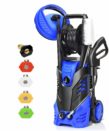A power washer also known as a pressure washer is one of the best tools to clean exterior surfaces, such as your garden, house sidings, patio furniture or even your cars. It’s much quicker and effective than using the traditional scrub brush, hence it’s becoming more and more popular. However, pay close attention to this tool since it produces pressure that can easily remove paint or damage objects in your backyard. Here are tips on how to use pressure washers efficiently and wisely.
Proper Handling
Before we tackle the usage of pressure washers, let me inform you about the proper handling of it. When using electric pressure washers, avoid extension cords as it can shorten the life of your pressure washer and may even void the warranty in some models. Also, the idea of pairing electricity and water will give a higher risk of electrocution if the cord isn’t properly grounded. When operating gas pressure washers, avoid using it inside your house or in an enclosed space. Gas pressure washers emit carbon monoxide which is harmful to any humans and can cause dizziness, headaches, nausea, or breathing difficulties. Its engine can get very hot easily so make sure to turn it off and let it cool before you put it away.
Pressure Level
Gauging the water pressure is important when using pressure washers. It can either work to your advantage and come in handy or damage your property if not properly handled.
- Electric pressure washers – The PSI (pounds per square inch) range of an electric pressure washer is between 1,300 to 1,400 PSI which is best for light to medium-duty jobs like washing cars and cleaning grills.
- Gas pressure washers – Unlike electric pressure washers, the gas-powered pressure washers average around 2,000 to 2,800 PSI which is needed for more heavy-duty jobs such as mildew stain removal, paint removal, and cleaning farm equipment.
Safety Tips
- Read the manual: If you’re new to this equipment, it’s recommended to read the manual on how to operate it. It also includes information about replacement parts, warranties, troubleshooting tips, and customer service.
- Avoid using the zero degree nozzle: This is the highest pressure nozzle which shoots a very strong stream of water. It can damage properties or even cause serious physical injuries.
- Wear protective gear: Don’t wear shorts and flip flops when using pressure washers. You should use goggles for your eyes, gloves for hands, steel-toed shoes for your feet, and pants for your legs.
- Hands off: Keep your hands and any body part away from the pressurized water. Remember, it can cause minor to severe physical injuries. Furthermore, don’t let your children near a pressure washer without the supervision of an adult.
- Don’t use ladders: When using pressure washers, don’t use ladders. Once the trigger is squeezed, it will produce a powerful recoil that is strong enough to throw you off balance.
Step-by-Step tips
- Prepare your water supply: Make sure that it can deliver GPM (gallons per minute) of water that is needed for your machine. Before operating the machine, make it a habit to check the water inlet or screen if it has debris or any object that can obstruct the water flow. Also, use garden hoses that are kink-free.
- Tighten all hose connections: Make sure that no air can enter between the hose connector and washer.
- Set the spray wand: To prevent kickback or recoil, set the spray to a-low or no-low pressure setting.
- Squeeze the spray wand trigger to release air pressure.
- Turn the faucet on fully.
- Start the engine.
- For an electric pressure washer: Plug into a grounded outlet and switch it on. For a gas pressure washer: Adjust the choke and throttle if necessary, then put your foot against the wheel to steady the machine and pull the starter cord to start the engine.
- Do a one-minute warm-up: It’s advisable to run water through the washer for one minute to warm up the engine.
- Secure the spray wand by holding it with both hands and plant feet firmly on the ground.
- Start using the pressure washer on low pressure about 18 inches from the cleaning surface. Move the spray in a side-to-side motion at a 45-degree angle to the surface.
- Keep moving the spray and don’t focus on one spot. This will prevent any property damages.
- If you want to add more pressure, try moving the spray closer to the object or surface, but not more than 6 inches away.
- Always engage the safety lock on the trigger when the washer is on idle or changing nozzle tips.




